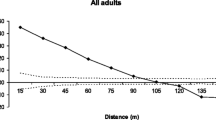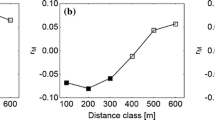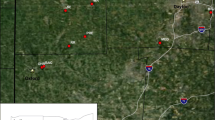Abstract
Ants are prominent seed dispersal agents in many ecosystems, and dispersal distances are small in comparison with vertebrate dispersal agents. However, the distance and distribution of ant-mediated dispersal in arid/semi-arid environments remains poorly explored. We used microsatellite markers and parentage assignment to quantify the distance and distribution of dispersed seeds of Acacia karina, retrieved from the middens of Iridomyrmex agilis and Melophorus turneri perthensis. From parentage assignment, we could not distinguish the maternal from each parent pair assigned to each seed, so we applied two approaches to estimate dispersal distances, one conservative (CONS), where the parent closest to the ant midden was considered to be maternal, and the second where both parents were deemed equally likely (EL) to be maternal, and used both distances. Parentage was assigned to 124 seeds from eight middens. Maximum seed dispersal distances detected were 417 m (CONS) and 423 m (EL), more than double the estimated global maximum. Mean seed dispersal distances of 40 m (±5.8 SE) (CONS) and 79 m (±6.4 SE) (EL) exceeded the published global average of 2.24 m (±7.19 SD) by at least one order of magnitude. For both approaches and both ant species, seed dispersal was predominantly (44–84 % of all seeds) within 50 m from the maternal source, with fewer dispersal events at longer distances. Ants in this semi-arid environment have demonstrated a greater capacity to disperse seeds than estimated elsewhere, which highlights their important role in this system, and suggests significant novel ecological and evolutionary consequences for myrmecochorous species in arid/semi-arid Australia.






Similar content being viewed by others
References
Andersen AN (1988) Dispersal distance as a benefit of myrmecochory. Oecologia 75:507–511
Auld TD (1986) Population dynamics of the shrub Acacia suavelons (Sm.) Willd.: dispersal and the dynamics of the soil seed bank. Aust J Ecol 11:235–254
Auld TD (1997) Ecology of the Fabaceae in the Sydney region: fire, ants and the soil seedbank. Cunninghamia 4:531–551
Beattie AJ, Culver DC (1983) The nest chemistry of two seed-dispersing ant species. Oecologia 56:99–103
Beaumont KP, Mackay DA, Whalen MA (2013) Multiphase myrmecochory: the roles of different ant species and effects of fire. Oecologia 172:791–803
Bond WJ, Stock WD (1989) The costs of leaving home: ants disperse myrmecochorous seeds to low nutrient sites. Oecologia 81:412–417
Boyd RS (2001) Ecological benefits of myrmecochory for the endangered chaparral shrub Fremontodendron decumbens (Sterculiaceae). Am J Bot 88:234–241
Bronstein JL, Alarcon R, Geber M (2006) The evolution of plant–insect mutualisms. New Phytol 172:412–428
Clobert J, Danchin E, Dhondt AA, Nichols JD (eds) (2001) Dispersal. Oxford University Press, Oxford
Culver DC, Beattie AJ (1978) Myrmecochory in Viola: dynamics of seed–ant interactions in some West Virginia species. J Ecol 66:53–72
Davidson DW, Morton SR (1981) Myrmecochory in some plants (F. Chenopodiaceae) of the Australian arid zone. Oecologia 50:357–366
Gibson MR, Richardson DM, Marchante E, Marchante H, Rodger JG, Stone GN, Byrne M, Fuentes-Ramírez A, George N, Harris C et al (2011) Reproductive biology of Australian acacias: important mediator of invasiveness? Divers Distrib 17:911–933
Giladi I (2006) Choosing benefits or partners: a review of the evidence for the evolution of myrmecochory. Oikos 112:481–492. doi:10.1111/j.0030-1299.2006.14258.x
Gómez C, Espadaler X (1998) Myrmecochorous dispersal distances: a world survey. J Biogeogr 25:573–580. doi:10.1046/j.1365-2699.1998.2530573.x
Gómez C, Espadaler X (2013) An update of the world survey of myrmecochorous dispersal distances. Ecography 36:1193–1201. doi:10.1111/j.1600-0587.2013.00289.x
Gove AD, Majer JD, Dunn RD (2007) A keystone ant species promotes seed dispersal in a diffuse mutualism. Oecologia 153:687–697
Hamrick JL, Trapnell DW (2011) Using population genetic analyses to understand seed dispersal patterns. Acta Oecologia 37:641–649
Hanski I, Saccheri I (2006) Molecular-level variation affects population growth in a butterfly metapopulation. PLoS Biol 4:e129. doi:10.1371/journal.pbio.0040129
Hanzawa F, Beattie AJ, Culver D (1988) Directed dispersal: demographic analysis of an ant-seed mutualism. Am Nat 131:1–13
Hardesty BD, Hubbell SP, Bermingham E (2006) Genetic evidence of frequent longdistance recruitment in a vertebrate dispersed tree. Ecol Lett 9:516–525
Hardy OJ, Vekemans X (2002) SPAGeDI: a versatile computer program to analyse spatial genetic structure at the individual or population levels. Mol Ecol Notes 2:618–620. doi:10.1046/j.1471-8286.2002.00305.x
He T, Krauss SL, Lamont BB, Miller BP, Enright NJ (2004) Long-distance seed dispersal in a metapopulation of Banksia hookeriana inferred from a population allocation analysis of amplified fragment length polymorphism data. Mol Ecol 13:1099–1109
He TH, Lamont BB, Krauss SL, Enright NJ, Miller BP, Gove AD (2009) Ants cannot account for interpopulation dispersal of the arillate pea Daviesia triflora. New Phytol 181:725–733. doi:10.1111/j.1469-8137.2008.02686.x
Heithaus ER (1981) Seed predation by rodents on 3 ant-dispersed plants. Ecology 62:136–145
Heterick BE (2009) A guide to the ants of south-western Australia. Records of the Western Australian Museum, Supplement 79, 205 pp
Heterick BE, Shattuck S (2011) Revision of the ant genus Iridomyrmex (Hymenoptera: Formicidae). Zootaxa 2845:1–174
Hopper SD (2009) OCBIL theory: towards an integrated understanding of the evolution, ecology and conservation of biodiversity on old, climatically-buffered, infertile landscapes. Plant Soil 322:49–86. doi:10.1007/s11104-009-0068-0
Jansen PA, Visser MD, Joseph Wright S, Rutten G, Muller-Landau HC (2014) Negative density dependence of seed dispersal and seedling recruitment in a Neotropical palm. Ecol Lett 17:1111–1120
Jones AG, Small CM, Paczolt KA, Ratterman NL (2010) A practical guide to methods of parentage analysis. Mol Ecol Res 10:6–30. doi:10.1111/j.1755-0998.2009.02778.x
Kalisz S, Hanzawa FM, Tonsor SJ, Thiede DA, Voigt S (1999) Ant-mediated seed dispersal alters patterns of relatedness in a population of Trillium grandiflorum. Ecology 80:2620–2634. doi:10.1890/0012-9658(1999)080[2620:amsdap]2.0.co;2
Keith DA, Akçakaya HR, Thuiller W, Midgley GF, Pearson RG, Phillips SJ, Regan HM, Araújo MB, Rebelo TG (2008) Predicting extinction risks under climate change: coupling stochastic population models with dynamic bioclimatic habitat models. Biol Lett 4:560–563
Koelewijn HP (2004) Sibling competition, size variation and frequency-dependent outcrossing advantage in Plantago coronopus. Evol Ecol 18:51–74
Lamont BB, Downes S, Fox JED (1977) Importance-value curves and diversity indices applied to a species rich heath-land in Western Australia. Nature 265:438–441
Lengyel S, Gove AD, Latimer AM, Majer JD, Dunn RR (2009) Ants sow the seeds of global diversification in flowering plants. PLoS ONE 4:1–6. doi:10.1371/journal.pone.0005480
Lengyel S, Gove AD, Latimer AM, Majer JD, Dunn RR (2010) Convergent evolution of seed dispersal by ants, and phylogeny and biogeography in flowering plants: a global survey. Perspect Plant Ecol Evol Syst 12:43–55. doi:10.1016/j.ppees.2009.08.001
Majer JD (1980) The influence of ants on broadcast and naturally spread seed in rehabilitated bauxite mined areas. Reclam Rev 3:3–9
Majer JD (1982) Ant–plant interactions in the Darling Botanical District of Western Australia. In: Buckley R (ed) Ant–plant Interactions in Australia. Springer, Dordrecht, pp 45–61
Majer JD (1984) The influence of ants on seeding operations in northern Australian mined areas. Reclam Reveg Rev 2:299–313
Majer JD, Gove AD, Sochacki S, Searle P, Portlock C (2011) A comparison of the autecology of two seed-taking ant genera, Rhytidoponera and Melophorus. Insectes Soc 58:115–125
Marchante H, Freitas H, Hoffmann JH (2010) Seed ecology of an invasive alien species, Acacia longifolia (Fabaceae), in Portuguese dune ecosystems. Am J Bot 97:1780–1790. doi:10.3732/ajb.1000091
Marshall TC, Slate J, Kruuk LER, Pemberton JM (1998) Statistical confidence for likelihood-based paternity inference in natural populations. Mol Ecol 7:639–655
Maslin BR, Buscumb C (2007) Two new Acacia species (Leguminosae: Mimosoideae) from banded ironstone ranges in the Midwest region of south-west Western Australia. Nuytsia 17:263–272
Millar MA, Byrne M, Nuberg I, Sedgley M (2008) High outcrossing and random pollen dispersal in a planted stand of Acacia saligna subsp. saligna revealed by paternity analysis using microsatellites. Tree Genet Genomes 4:367–377
Millar MA, Byrne M, Nuberg IK, Sedgley M (2012) High levels of genetic contamination in remnant populations of Acacia saligna from a genetically divergent planted stand. Restor Ecol 20:260–267
Millar MA, Coates DJ, Byrne M (2014) Extensive long-distance pollen dispersal and highly outcrossed mating in historically small and disjunct populations of Acacia woodmaniorum (Fabaceae), a rare banded iron formation endemic. Ann Bot 114:961–971
Mittermeier RA (2004) Hotspots revisited. University of Chicago Press, Chicago
Montesinos D, Castro S, Rodríguez-Echeverría S (2012) Invasive acacias experience higher ant seed removal rates at the invasion edges. Web Ecol 12:33–37
Myers N, Mittermeier RA, Mittermeier CG, Dafonesca GAB, Kent J (2000) Biodiversity hotspots for conservation priorities. Nature 40:853–858
Nathan R, Muller-Landau HC (2000) Spatial patterns of seed dispersal, their determinants and consequences for recruitment. Trends Ecol Evol 15:278–285
Nathan R, Klein EK, Robledo-Arnuncio JJ, Revilla E (2013) Dispersal kernels. In: Clobert J, Baguette M, Benton TG, Bullock JM (eds) Dispersal and spatial evolutionary ecology. Oxford University Press, Oxford, pp 496
Ness JH (2004) Forest edges and fire ants alter the seed shadow of an ant-dispersed plant. Oecologia 138:448–454
Nevill PG, Anthony JM, Krauss SL (2010) Isolation and characterization of microsatellite markers for the banded ironstone endemic Acacia karina (Leguminosae: Mimosaceae) and cross-species amplification with A. stanleyi and A. jibberdingensis. Conserv Genet Resour 2:321–323. doi:10.1007/s12686-010-9219-0
Nevill PG, Wallace MJ, Miller JT, Krauss SL (2013) DNA barcoding for conservation, seed banking and ecological restoration of Acacia in the Midwest of Western Australia. Mol Ecol Resour 13:1033–1042. doi:10.1111/1755-0998.12060
O’Dowd DJ, Hay ME (1980) Multalism between harvester ants and a desert ephemeral: seed escape from rodents. Ecology 61:531–540
Pascov C (2013) Realised pollen and seed dispersal inferred from parentage analysis in Acacia karina. Honours thesis, The University of Western Australia, Perth
Passos L, Oliveira PS (2003) Interactions between ants, fruits, and seeds in restinga forests on south-eastern Brazil. J Trop Ecol 19:261–270
Peakall R, Smouse PE (2012) GenAlEx 6.5: genetic analysis in Excel. Population genetic software for teaching and research—an update. Bioinformatics 28:2537–2539. doi:10.1093/bioinformatics/bts460
Pudlo RJ, Beattie AJ, Culver DC (1980) Population consequences of changes in an ant-seed mutualism in Sanguinaria canadensis. Oecologia 46:32–37
Schatral A, Kailis SG, Fox JED (1994) Seed dispersal by Hibbertia hypericoides (Dilleniaceae) by ants. J R Soc West Aust 77:81–85
Selkoe KA, Toonen RJ (2006) Microsatellites for ecologists: a practical guide to using and evaluating microsatellite markers. Ecol Lett 9:615–629. doi:10.1111/j.1461-0248.2006.00889.x
Shattuck SO (1992) Generic revision of the ant subfamily Dolichoderinae (Hymenoptera: Formicide). Sociobiology 21:1–181
Stone GN, Raine NE, Prescott M, Willmer PG (2003) Pollination ecology of acacias (Fabaceae, Mimosoideae). Aust Syst Bot 16:103–118
Trakhtenbrot A, Nathan R, Perry G, Richardson DM (2005) The importance of long-distance dispersal in biodiversity conservation. Divers Distrib 11:173–181. doi:10.1111/j.1366-9516.2005.00156.x
van der Pijl L (1982) Principles of dispersal in higher plants. Springer, Berlin
Vekemans X, Hardy OJ (2004) New insights from fine-scale spatial genetic structure analyses in plant populations. Mol Ecol 13:921–935
Wandrag EM, Sheppard A, Duncan RP, Hulme PE (2013) Mutualism vs. antagonism in introduced and native ranges: can seed dispersal and predation determine Acacia invasion success? Perspect Plant Ecol Evol Syst 15:171–179
Whitney KD (2002) Dispersal for distance? Acacia ligulata seeds and meat ants Iridomyrmex viridiaeneus. Aust Ecol 27:589–595
Wright S (1943) Isolation by distance. Genetics 28:114–138
Young JP (1981) Sib competition can favour sex in two ways. J Theor Biol 88:755–756
Acknowledgments
We thank Karara Mining Ltd for funding, Brian Heterick (Curtin University) for his assistance in identification of ant species collected from the field and comments on their biology and Melanie Britton for laboratory assistance. Phyllode and seed material was collected under permit number 63-1314 issued to SK under the Western Australian Wildlife Conservation Act 1950. The authors declare that they have no conflict of interest.
Author contribution statement
PGN originally formulated the idea. PGN, CMP, CPE, JDM, JA and SLK designed the study. PGN, CMP, CPE and JA collected the samples and/or data. CMP, CPE and SLK analysed the data. CMP, PGN CPE, JDM and SLK wrote the manuscript.
Author information
Authors and Affiliations
Corresponding author
Additional information
Communicated by Carlos L. Ballare.
Rights and permissions
About this article
Cite this article
Pascov, C.M., Nevill, P.G., Elliott, C.P. et al. The critical role of ants in the extensive dispersal of Acacia seeds revealed by genetic parentage assignment. Oecologia 179, 1123–1134 (2015). https://doi.org/10.1007/s00442-015-3400-9
Received:
Accepted:
Published:
Issue Date:
DOI: https://doi.org/10.1007/s00442-015-3400-9




